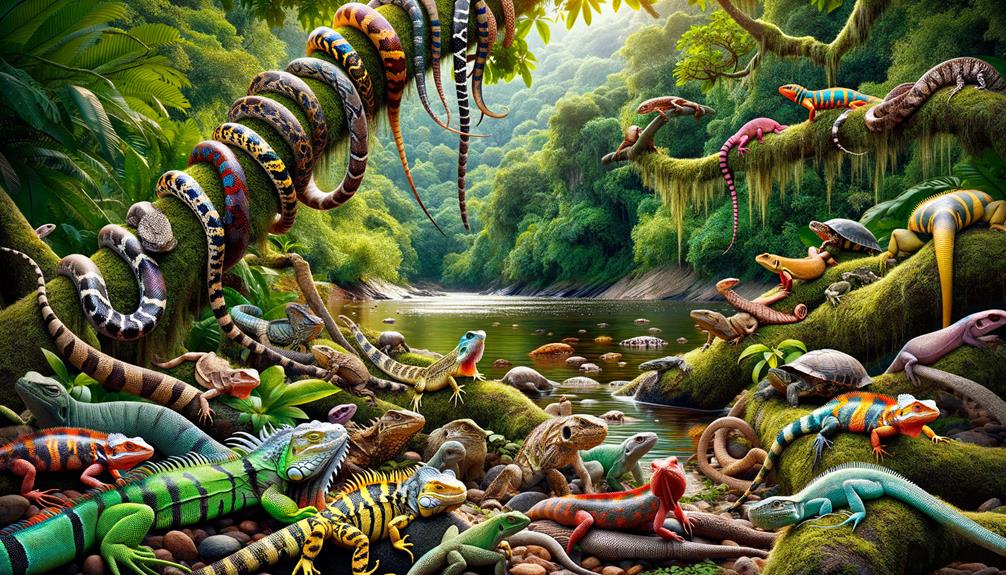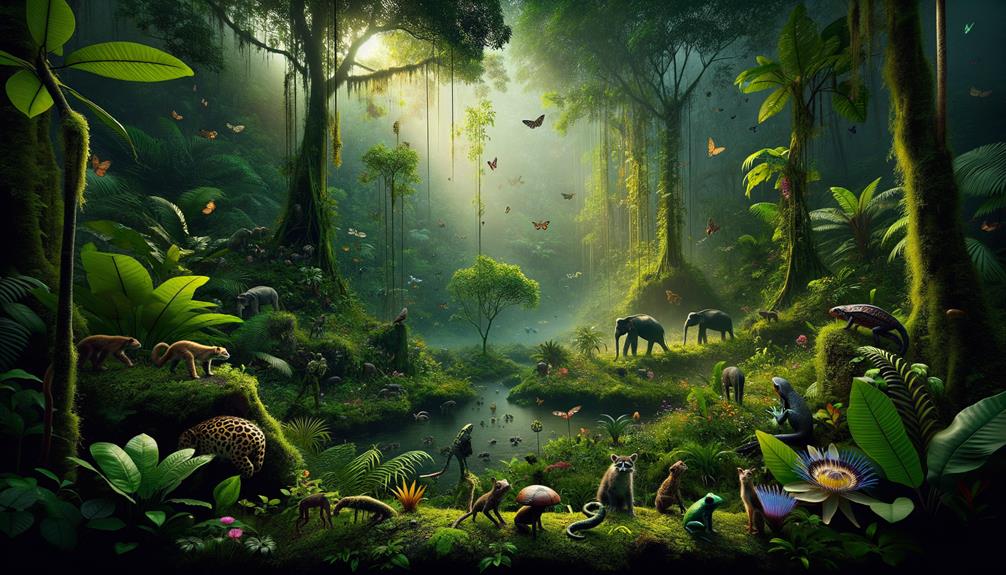Papua New Guinea is a haven for reptile enthusiasts, boasting over 200 endemic lizard species. The crocodile skink and Solomons wedge skink are just a few of the many fascinating creatures that call this island home. The mangrove monitor lizard thrives in the lush coastal mangroves, while the snake-like Lialis burtonis slithers through the underbrush. Two distinct crocodile species, the massive saltwater crocodile and the endemic New Guinea crocodile, play vital ecological roles. The island’s unique ecosystem is also home to a diverse array of snakes and sea turtles, each with their own intriguing stories waiting to be uncovered.
Key Takeaways
Papua New Guinea is a haven for reptile enthusiasts, boasting over 200 endemic lizard species, including unique skinks, geckos, and monitor lizards. The New Guinea crocodile plays a vital role in maintaining the island’s ecological balance. The New Guinea olive python, one of the world’s largest snakes, is surprisingly gentle in nature. Some skinks, like Tribolonotus gracilis, exhibit fascinating behaviors, such as jumping. Critically endangered sea turtles, including hawksbill and leatherback, inhabit Papua New Guinea’s coastal waters.
Diverse Lizard Species
New Guinea’s lizard fauna is remarkably diverse, boasting over 200 endemic species, including geckos, skinks, and monitor lizards, each contributing uniquely to the island’s rich ecological tapestry. As I explored this vibrant world, I was struck by the sheer variety. Take Varanus indicus, the mangrove monitor, for instance. This agile lizard thrives in coastal mangrove forests, showcasing remarkable resilience and adaptability. Then there’s Lialis burtonis, the peculiar snake-lizard, which defies convention with its elongated, serpentine body.
Equally captivating is the crocodile skink, resembling a miniature dragon with its armored scales and piercing eyes. This creature seems almost mythical, yet it’s a testament to the island’s evolutionary wonders. The enigmatic Corucia zebrata, or Solomon Islands skink, is another marvel, known for its social behavior and unique prehensile tail.
Among the largest species, Crocodylus porosus, the saltwater crocodile, demands respect and awe. Meanwhile, Tiliqua gigas, the giant blue-tongued skink, impresses with its vibrant tongue and robust build. Finally, the pig-nosed turtle, Carettochelys insculpta, showcases the island’s aquatic diversity with its distinctive snout and flipper-like limbs.
Unique Skinks
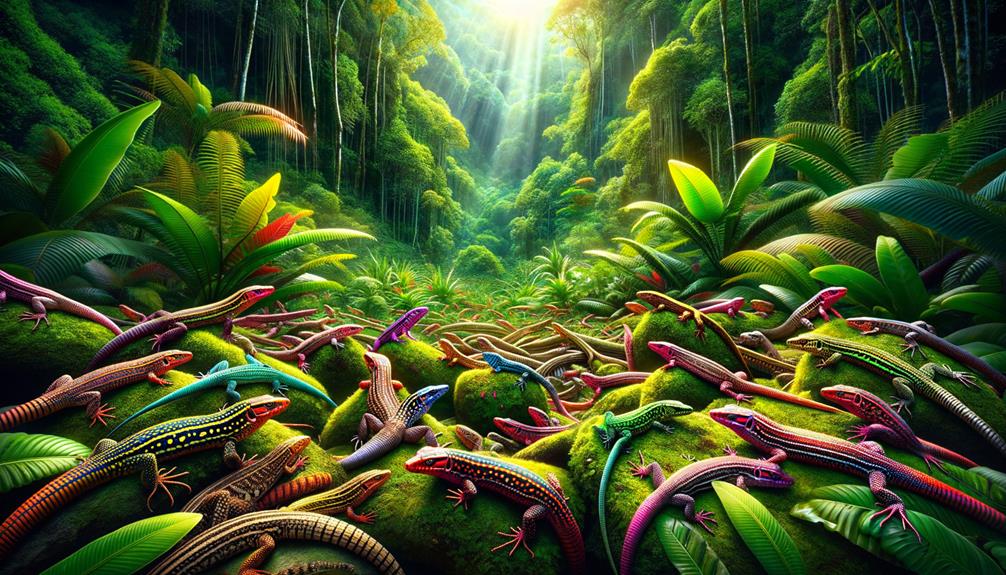
In Papua New Guinea’s lush landscapes, I was struck by the unique skinks that inhabit the island. With over 200 species, these fascinating creatures showcase the island’s incredible biodiversity. Over 60% of these skinks are found nowhere else on earth, making Papua New Guinea a true hotspot for reptile enthusiasts. The Sphenomorphus genus, in particular, boasts some remarkable species, such as the Solomons wedge skink and the Jobi skink. These skinks have adapted to the island’s varied volcanic and forested terrains, each species intricately suited to its environment.
The sleek, long-legged Emoia skinks are a marvel to observe. Agile and swift, they dart through the underbrush with ease, their quick movements and sharp instincts making them a thrill to watch. Then there’s the endemic Tribolonotus gracilis, also known as the red-eyed crocodile skink. This remarkable creature is known for its unique jumping action when protecting its egg clutches, a testament to the island’s incredible evolutionary history.
The sheer diversity of skinks in Papua New Guinea, from the brown four-fingered skinks to the various Emoia species, reflects the island’s rich tapestry of life. Each encounter with these remarkable creatures deepens my appreciation for this vibrant ecosystem and the incredible adaptations that have evolved within it.
Crocodiles of Papua New Guinea
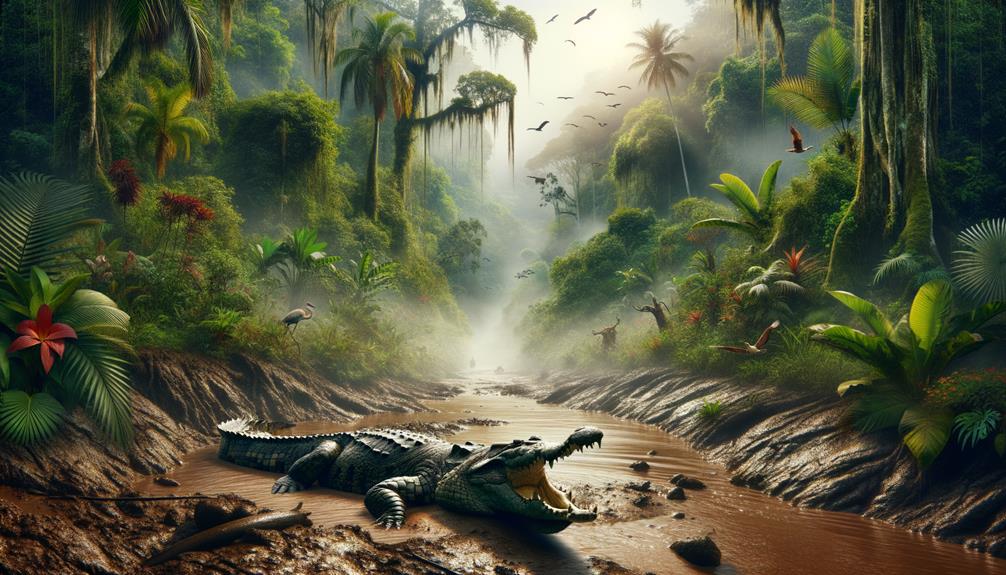
In Papua New Guinea’s diverse ecosystems, two formidable crocodile species command attention and respect: the saltwater crocodile (Crocodylus porosus) and the endemic New Guinea crocodile (Crocodylus novaeguineae). The saltwater crocodile, the largest living reptile, can reach astonishing lengths of up to 7 meters. It thrives in the coastal regions of northern Australia and southern New Guinea. On the other hand, the New Guinea crocodile, with its more restricted distribution, is endemic to the island, embodying the unique biodiversity of the region.
Conservation efforts are crucial in protecting these majestic creatures. Both crocodile species have faced significant population declines due to hunting for meat and hides, and habitat loss from human development. Fortunately, Papua New Guinea has implemented management plans to safeguard their wetland habitats and guarantee their survival.
To appreciate these fascinating reptiles, consider the following points:
- The saltwater crocodile is a skilled navigator of both saltwater and freshwater environments.
- The New Guinea crocodile’s restricted habitat makes it a symbol of New Guinea’s unique wildlife.
- Conservation programs aim to strike a balance between human needs and wildlife preservation.
- Both species play vital roles in their ecosystems, maintaining ecological balance.
Fascinating Snakes
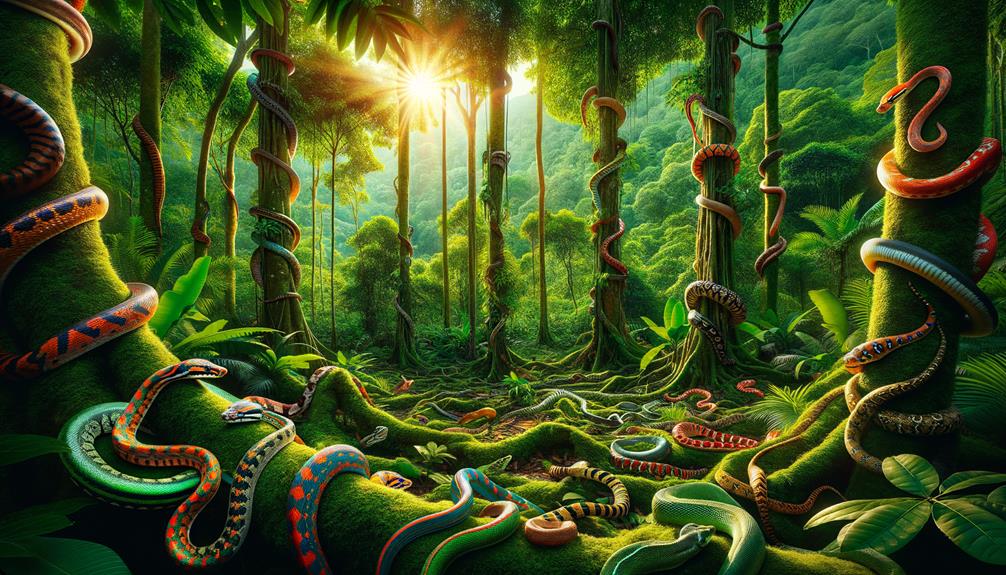
Papua New Guinea’s rich tapestry of snake species offers a fascinating glimpse into the island’s unique and diverse reptilian fauna. The New Guinea olive python, one of the six largest snakes in the world, is a gentle giant that captures the imagination of reptile enthusiasts with its sheer size.
At the other end of the spectrum, the slender, nonvenomous New Guinea bronzeback snake darts through the treetops with agility and grace, providing a stark contrast to the island’s more formidable residents, such as the highly venomous Eastern brown snake, which is found in both Australia and southern New Guinea.
The brown tree snake, notorious for its invasive impact in Guam, also thrives in New Guinea. Its arboreal and rear-fanged nature makes it a fascinating subject of study. But snakes aren’t the only reptiles that draw attention here. The island’s Mangrove monitor lizard, a versatile and adaptive creature, shares its habitat with these serpentine wonders, adding to the complex web of interactions in this ecosystem.
Papua New Guinea’s snakes, from the massive olive python to the agile bronzeback, showcase the island’s extraordinary biodiversity, promising endless exploration for those captivated by the wild and free.
Sea Turtles and Other Reptiles
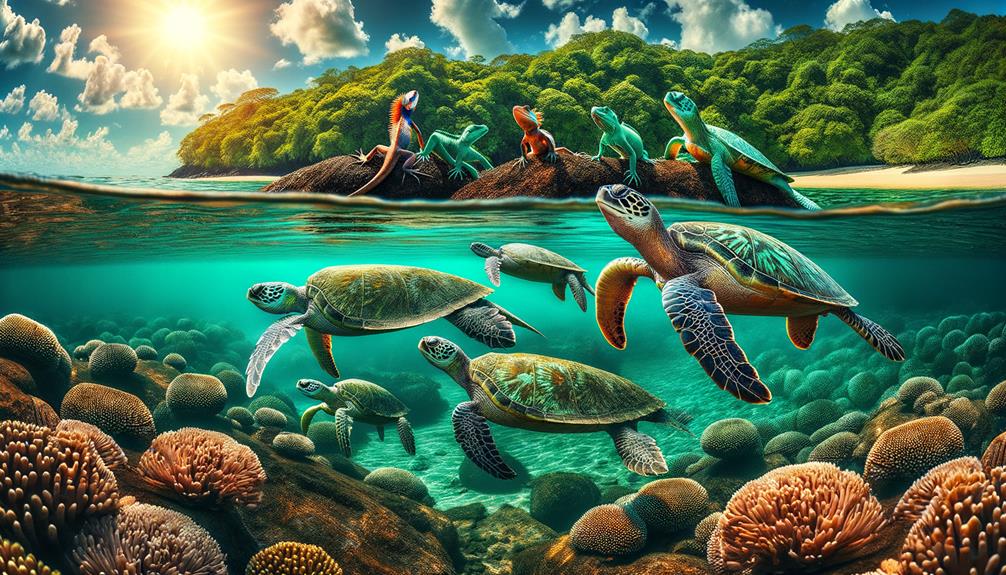
New Guinea’s coastal and marine environments are home to an impressive array of sea turtles and other reptiles. The leatherback sea turtle, which can reach an impressive 1.8 meters in length, is a majestic sight in the waters around Papua New Guinea. The green sea turtle is notable for the green fat beneath its carapace, setting it apart from other species.
Papua New Guinea is also home to the loggerhead sea turtle, an oceanic wanderer measuring around 90 cm in carapace length. The critically endangered hawksbill sea turtle, the sole surviving species in the genus Eretmochelys, adds a touch of rarity to the island’s marine life. The olive ridley sea turtle, the second-smallest and most abundant of all sea turtles, thrives in these waters.
Besides sea turtles, the island of New Guinea boasts river turtles and several species of crocodile, creating a rich tapestry of reptilian life. Each of these species, whether endemic to the island or oceanic visitors, contributes to the unique biodiversity of Papua New Guinea.
Observe the leatherback sea turtle in its natural habitat. Learn about the green sea turtle’s distinctive features. Find out about conservation efforts for the critically endangered hawksbill sea turtle. Explore the diverse reptilian life, including river turtles and crocodiles.
Frequently Asked Questions
What Is the Most Unique Reptile?
Choosing the most unique reptile is a tough call, but the pig-nosed turtle really stands out from the crowd. Its flipper-like limbs and distinctive pig-like snout make it a true original.
What Is the Big Lizard in Papua New Guinea?
The big lizard in Papua New Guinea is the crocodile monitor. This remarkable creature can grow over 2 meters long, making its home in trees, and feeds on small mammals and birds. Due to its restricted habitat, it’s considered near-threatened.
Does Papua New Guinea Have Komodo Dragons?
Papua New Guinea doesn’t have Komodo dragons. These incredible creatures are only found in Indonesia. However, Papua New Guinea is home to a wide variety of unique reptiles that are sure to thrill enthusiasts.
What Are the Unique Reptiles in New Zealand?
New Zealand is home to some truly unique reptiles, including the ancient tuatara, a species that has remained largely unchanged for millions of years. The country is also home to a variety of skinks, such as McGregor’s and black-backed skinks, which are known for their vibrant colors. Additionally, New Zealand is home to several species of viviparous geckos, including the common forest gecko. Unfortunately, these species face numerous threats, including habitat loss, predators, and climate change, which put their populations at risk.


